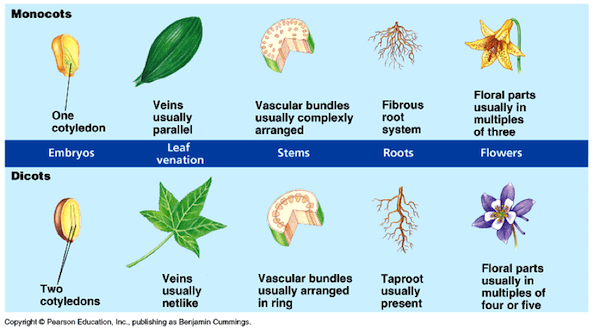Dicots: Difference between revisions
| Line 8: | Line 8: | ||
== History == | == History == | ||
Angiosperms have traditionally been divided into two major classes, the Magnoliopsida (Dicots), and the Liliopsda (Monocots), although botanists have not always recognized these as the two fundamental groups of angiosperms. Theophrastus was first credited with recognizing the difference between the two groups around 370 BC, but classification of the plants based on overall growth form was not established until the 1600s. | Angiosperms have traditionally been divided into two major classes, the Magnoliopsida (Dicots), and the Liliopsda (Monocots), although botanists have not always recognized these as the two fundamental groups of angiosperms. Theophrastus was first credited with recognizing the difference between the two groups around 370 BC, but classification of the plants based on overall growth form was not established until the 1600s. | ||
Recent studies using two known fossil nodes and the Li–Tanimura method, estimate that monocots branched off from dicots 140–150 million years ago during the late Jurassic–early Cretaceous period. This is around 50 million years younger than previous estimates that were based solely on the molecular clock hypothesis. This study also estimates that the core eudicots diverged 100–115 million years ago during the Cretaceous period, indicating that both the divergence of monocots from dicots, as well as the core eudicot’s age are older than their respective fossil records. | |||
== Formation and Differentiation from Monocots == | == Formation and Differentiation from Monocots == | ||
Revision as of 19:43, 8 March 2018
Definition

A dicotyledon (commonly referred to as a dicot) is an angiospermous plant with two cotyledons and having an exogenous manner of growth. Cotyledons are the “seed leaves” that absorb nutrients within the seed until the plant can produce true leaves and begin photosynthesis. The term dicotyledon refers to the group containing seeds with two cotyledons, rather than one. Monocotyledons are the remaining group that contains seeds with only one cotyledon. There are about 175,000 known species of dicots, about half of which are woody. These plants show a yearly increase in stem diameter due to the production of new tissue by the cambium, which is a layer of cells that continue to divide throughout the life of a plant.
History
Angiosperms have traditionally been divided into two major classes, the Magnoliopsida (Dicots), and the Liliopsda (Monocots), although botanists have not always recognized these as the two fundamental groups of angiosperms. Theophrastus was first credited with recognizing the difference between the two groups around 370 BC, but classification of the plants based on overall growth form was not established until the 1600s.
Recent studies using two known fossil nodes and the Li–Tanimura method, estimate that monocots branched off from dicots 140–150 million years ago during the late Jurassic–early Cretaceous period. This is around 50 million years younger than previous estimates that were based solely on the molecular clock hypothesis. This study also estimates that the core eudicots diverged 100–115 million years ago during the Cretaceous period, indicating that both the divergence of monocots from dicots, as well as the core eudicot’s age are older than their respective fossil records.
Formation and Differentiation from Monocots
Once an angiosperm has been pollenated, two sperm will drop into the embryonic sac where one will fuse with the egg to form a zygote, and the other will fuse with the two nuclei of the central cell and become an endosperm nucleus. This is referred to as double fertilization, as the true fertilization is accompanied by another fusion process that resembles fertilization. This type of double fertilization is a trait unique to angiosperms. The zygote is now diploid, and the endosperm nucleus is triploid. The endosperm nucleus undergoes mitosis to form the endosperm of the seed, a nutrient-rich tissue utilized by the developing embryo and germinating seed.
The zygote then undergoes a series of mitotic divisions to form an undifferentiated embryo. Differentiation of the embryo requires the development of a radicle (apical meristem) next to the suspensor from where the root will begin growing, and the development of one cotyledon (in monocotyledons) or two cotyledons (in dicotyledons) at the opposite end from the suspensor. A shoot apical meristem is the site of stem differentiation, differentiating between the two cotyledons or forming next to the single cotyledon.
While the primary difference between these two groups lies in their seed structure, there are several additional differences that designate a flowering plant as either mono or dicot.
Roots
The roots of monocots branch off in many different directions resembling a fibrous web. Monocot roots remain primarily in the upper level of soil and do not dig as deep down as do dicot roots. Dicots have one main “taproot” off of which smaller roots branch off. This structure allows the root to grow down further rather than expending energy spreading outwards.

Pollen Structure
Monocots retain the first angiosperm’s pollen structure which contained a single pore through it’s outer layer, known as monosulcate. Dicots descended from a plant which contained three pores in it’s pollen, known as triporate.
Stems
The vascular bundles in monocots are arranged sporadically throughout the stem in no particular pattern. Dicots all contain vascular bundles that are arranged in a ring around the outer edge of the vascular tissue. Vascular tissue can be thought of as the circulatory system of a plant, and therefore the distinction in bundles is important to note.
Leaves
In monocot plants, leaves are characterized by parallel veins and typically thin leaves. The leaf structure of dicots is branched or webbed veins throughout the leaf structure
Flowers
In monocot plants, the number of petals, stamens, or other floral parts will typically be a number divisible by three; usually either three or six. Dicot flowers on the other hand, tend to have parts in multiples of four or five. This character is not always reliable, and can be misleading as certain flowers may be lacking parts.